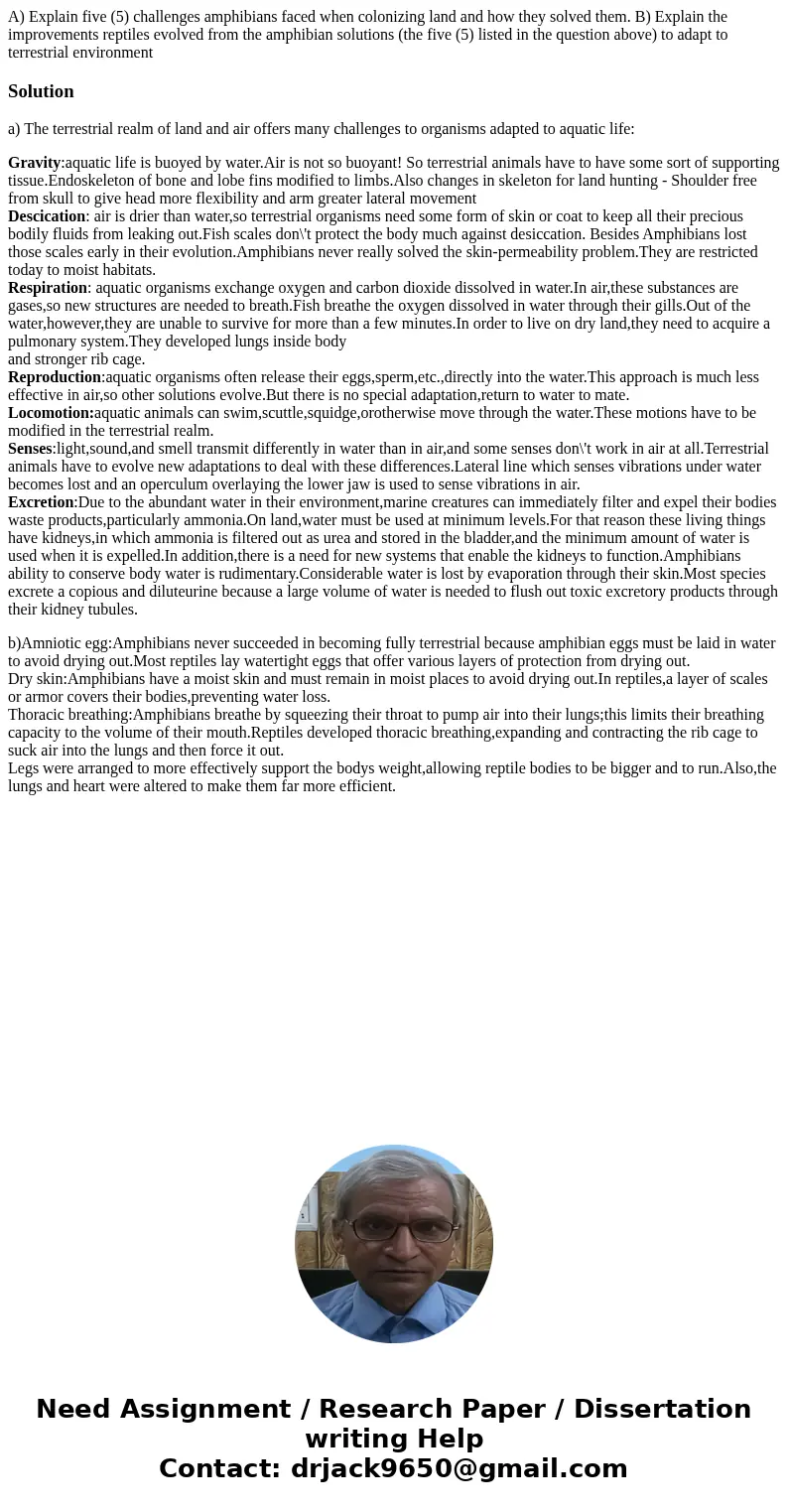A Explain five 5 challenges amphibians faced when colonizing
A) Explain five (5) challenges amphibians faced when colonizing land and how they solved them. B) Explain the improvements reptiles evolved from the amphibian solutions (the five (5) listed in the question above) to adapt to terrestrial environment
Solution
a) The terrestrial realm of land and air offers many challenges to organisms adapted to aquatic life:
Gravity:aquatic life is buoyed by water.Air is not so buoyant! So terrestrial animals have to have some sort of supporting tissue.Endoskeleton of bone and lobe fins modified to limbs.Also changes in skeleton for land hunting - Shoulder free from skull to give head more flexibility and arm greater lateral movement
Descication: air is drier than water,so terrestrial organisms need some form of skin or coat to keep all their precious bodily fluids from leaking out.Fish scales don\'t protect the body much against desiccation. Besides Amphibians lost those scales early in their evolution.Amphibians never really solved the skin-permeability problem.They are restricted today to moist habitats.
Respiration: aquatic organisms exchange oxygen and carbon dioxide dissolved in water.In air,these substances are gases,so new structures are needed to breath.Fish breathe the oxygen dissolved in water through their gills.Out of the water,however,they are unable to survive for more than a few minutes.In order to live on dry land,they need to acquire a pulmonary system.They developed lungs inside body
and stronger rib cage.
Reproduction:aquatic organisms often release their eggs,sperm,etc.,directly into the water.This approach is much less effective in air,so other solutions evolve.But there is no special adaptation,return to water to mate.
Locomotion:aquatic animals can swim,scuttle,squidge,orotherwise move through the water.These motions have to be modified in the terrestrial realm.
Senses:light,sound,and smell transmit differently in water than in air,and some senses don\'t work in air at all.Terrestrial animals have to evolve new adaptations to deal with these differences.Lateral line which senses vibrations under water becomes lost and an operculum overlaying the lower jaw is used to sense vibrations in air.
Excretion:Due to the abundant water in their environment,marine creatures can immediately filter and expel their bodies waste products,particularly ammonia.On land,water must be used at minimum levels.For that reason these living things have kidneys,in which ammonia is filtered out as urea and stored in the bladder,and the minimum amount of water is used when it is expelled.In addition,there is a need for new systems that enable the kidneys to function.Amphibians ability to conserve body water is rudimentary.Considerable water is lost by evaporation through their skin.Most species excrete a copious and diluteurine because a large volume of water is needed to flush out toxic excretory products through their kidney tubules.
b)Amniotic egg:Amphibians never succeeded in becoming fully terrestrial because amphibian eggs must be laid in water to avoid drying out.Most reptiles lay watertight eggs that offer various layers of protection from drying out.
Dry skin:Amphibians have a moist skin and must remain in moist places to avoid drying out.In reptiles,a layer of scales or armor covers their bodies,preventing water loss.
Thoracic breathing:Amphibians breathe by squeezing their throat to pump air into their lungs;this limits their breathing capacity to the volume of their mouth.Reptiles developed thoracic breathing,expanding and contracting the rib cage to suck air into the lungs and then force it out.
Legs were arranged to more effectively support the bodys weight,allowing reptile bodies to be bigger and to run.Also,the lungs and heart were altered to make them far more efficient.

 Homework Sourse
Homework Sourse